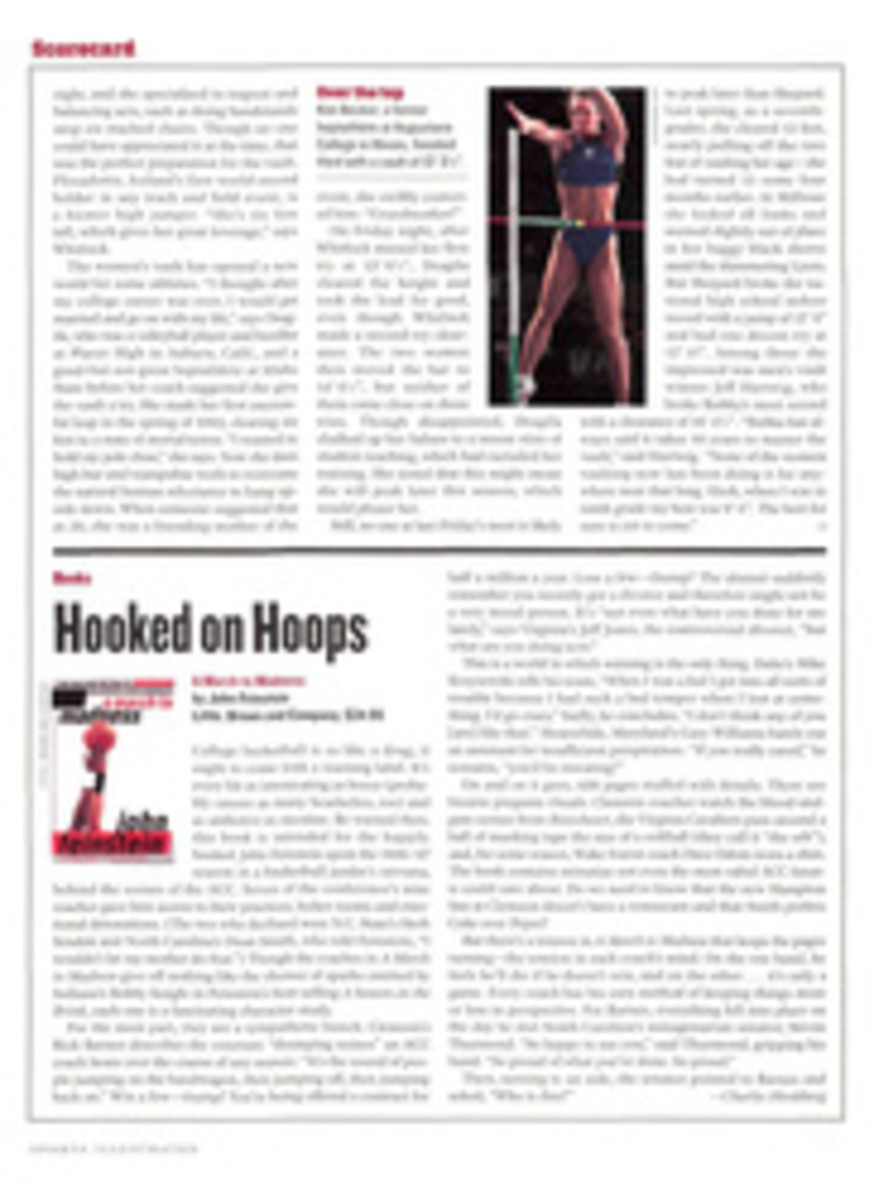
Immersed In His Work Marine cinematographer Al Giddings has filmed in every ocean on the planet
When Al Giddings hears would-be adventurers complain that there
are no new places to explore in the world, he laughs. "I've been
doing this for more than 30 years, and to me it's like a
continual Lewis and Clark expedition," he says. "There's been
one incredible discovery after another. I'm constantly seeing
things nobody has seen before."
Giddings's turf isn't a tenuous patch of rain forest. His realm
is the largest ecosystem on Earth, covering some 140 million
square miles, more than 70% of the planet's surface, and he has
the place largely to himself. Giddings's specialty is underwater
cinematography, a career he says he invented. "My job is a type
of ongoing treasure hunt," Giddings explains. "I look for
animals that have never been looked at, and I bring images of
them up from the depths so they can be studied and savored."
He estimates that he has spent more than 20,000 hours
underwater--in submarines, diving bells and scuba gear, and
sometimes just holding his breath (more on that later). Giddings
has peeked in every major ocean; he has dived off the coast of
Antarctica and beneath the pack ice of the North Pole; he has
visited the remains of the Titanic and the Andrea Doria; he has
produced the first professional underwater footage of white
sharks and blue whales and dozens of other species. Three of his
television documentaries, one on whales, another about sharks
and a third that chronicles the exploits of man in the sea, have
won Emmys.
Hollywood has also relied on his talents: Giddings was
responsible for the underwater sequences in two James Bond films
(For Your Eyes Only and Never Say Never Again) and in thrillers
such as The Deep and The Abyss.
In Titanic, for which he was a coproducer, Giddings filmed the
actual ship, which is submerged in the North Atlantic at a depth
of 12,640 feet. To reach it, Giddings and director James Cameron
used two 23-foot-long Russian submersibles, enduring a
three-hour descent to the ocean floor. Once there, Giddings and
his team worked 12 to 14 hours at a time, filming the wreckage
with a remote-control camera mounted to a hydraulic arm and
aided by a 20,000-watt lighting system operated from the second
sub. He made 17 such trips.
Typically, Giddings travels eight months per year--he recently
returned from a month in Cuba, where he was filming a
documentary for the Discovery Channel--searching the seas with a
zeal that borders on obsession. Those few weeks a year when he
is planted on terra firma, he lives on a 3,500-acre ranch in
Montana's Paradise Valley, a few miles north of Yellowstone
National Park. Here he designs and builds, with the help of a
half dozen employees, the world's most sophisticated underwater
imaging systems. Off-the-shelf equipment has never satisfied
Giddings's demands. He has introduced many innovations in
underwater filming and lighting, including more adaptable
casings and lenses.
Now 60, Giddings is a large man, with thick arms, thick fingers
and steel-blue eyes. His voice sounds as though it has been
filtered through a bass drum. Decades of diving have taken a
toll on his body. Once, while lifting heavy equipment on the
seabed, he suffered a collapsed lung. Another time he lost his
sight temporarily from a case of the bends. His hearing, he
says, is bad as a result of his eardrums breaking over and over,
because of the increased pressure underwater.
Giddings grew up in Marin County, near San Francisco. Though
Northern California's waters are notoriously inhospitable,
Giddings was unable to resist. "I'd go down to the cliffs and
jump in the ocean," he says. "It was cold and murky and damn
rough. Most people didn't want to take that kind of abuse. I
liked it."
Soon, he started free diving, holding his breath for as long as
five minutes and descending to more than 100 feet. It was a
dangerous activity but Giddings was smitten. "I've always felt
completely comfortable in the water," he says. On his high
school swim team Giddings turned in near Olympic times in the
50- and 100-yard freestyle and was offered scholarships to
Stanford and Ohio State. "But I blew that all off," he says. "I
wanted to be a deep-sea diver."
His first brush with fame came in 1954. A friend of Giddings's,
an anesthesiologist, began experimenting with hyperbaric therapy
techniques, using pure oxygen. Giddings practiced with his
friend, and at a sporting goods show in San Francisco, with
1,000 people watching, he dived into a swimming pool and
remained on the bottom for 11 minutes and 42 seconds before
emerging. "It was around-the-world news," says Giddings, whose
feat made The Guinness Book of Records.
Around the same time, he taught himself how to dive using scuba
gear. At first Giddings did his scuba diving with a speargun in
hand; his object, after all, was to kill fish. "Eventually,"
says Giddings, "I came to the realization that it would be more
interesting to shoot with a camera than with a gun." The
problem, however, was that he couldn't find an underwater camera
that suited him. So, in 1959, Giddings set about building one.
"I took a 1946 Ford oil filter--one of those old round-bowl
filters--and I machined, by hand, a front lens for it. I put my
camera in there and some crude controls so I could wind it and
fire the shutter."
He promptly sold a photo of three perch hovering over a rock
near Catalina to Motorland magazine. "They paid me $25," recalls
Giddings. "I thought it was the greatest thing in the world. I
wondered if I could possibly make a living doing this."
In the years since, Giddings has built underwater housings for
hundreds of cameras--both for still images and, later, motion
pictures. He has been behind the camera for some of the most
epochal moments in underwater filming history. In 1965, near
Hawaii, he recorded the first motion pictures of whales swimming
below the surface. "That first time," says Giddings, "my knees
were literally knocking. I was alone underwater with an
80,000-pound humpback, and nobody knew then whether the animal
would eat me alive." The whale's reaction to Giddings is
reflected in the title of the documentary in which Giddings's
footage was used: Gentle Giants.
Whales are Giddings's favorite animals. "Sharks are exciting to
encounter," he says, "but they have these expressionless black
eyes--they're sort of auto eating machines. Whales are so much
more provocative. The eye is really looking around, making
contact with you. You know you're being pondered by this
wonderful brain."
The highlight of Giddings's career came in 1995, when he
documented the discovery of a pod of 2,000 blue whales in the
waters off Northern California, a find that doubled the
creatures' known population. Because many whales are spooked by
air bubbles, Giddings had to revert to his breath-holding
techniques and dive without tanks. "I never thought I'd see a
blue whale in my lifetime, let alone film one," says Giddings.
"I saw 60 of them in one dive."
He has recently become enchanted with the possibilities of
high-definition television. "It will take your breath away,"
Giddings says. "The camera resolves such intimate details. The
human eye can't focus that close. I can fill the frame with just
an eyeball--it will almost be better than being there."
Giddings claims that in the age of high-definition TV, all the
footage he has filmed thus far will seem ugly by comparison.
"What it comes down to is this," says the man who never runs out
of places to explore, "everywhere I've ever been to, I now have
to go to again."
Michael Finkel lives in Bozeman, Mont., just down the road from
Al Giddings.
COLOR PHOTO: CHUCK NICKLIN/OCEAN IMAGES [Underwater diver and whale]
COLOR PHOTO: ANNE SHERWOOD [Al Giddings]
"My job is a treasure hunt. I look for animals that have never
been looked at."
Giddings filmed the original Titanic, in the North Atlantic, at
a depth of 12,640 feet.

